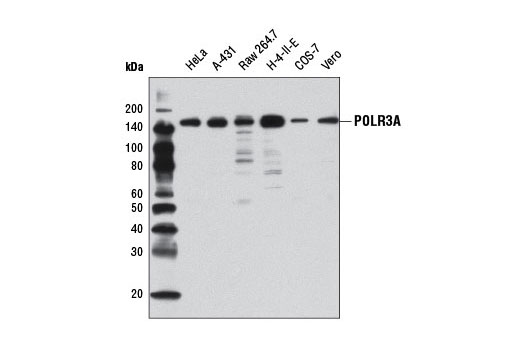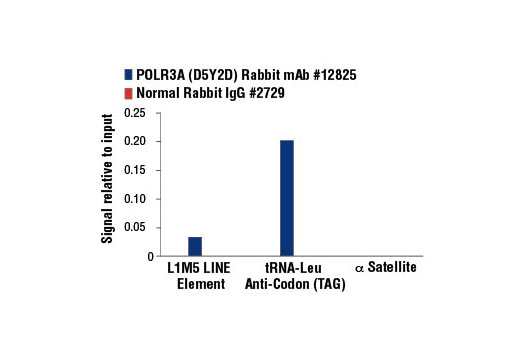WB, ChIP
H M R Mk
Endogenous
165
Rabbit IgG
#O14802
11128
Product Information
Product Usage Information
For optimal ChIP results, use 10 μl of antibody and 10 μg of chromatin (approximately 4 x 106 cells) per IP. This antibody has been validated using SimpleChIP® Enzymatic Chromatin IP Kits.
| Application | Dilution |
|---|---|
| Western Blotting | 1:1000 |
| Chromatin IP | 1:50 |
Storage
Specificity / Sensitivity
Species Reactivity:
Human, Mouse, Rat, Monkey
Species predicted to react based on 100% sequence homology
The antigen sequence used to produce this antibody shares
100% sequence homology with the species listed here, but
reactivity has not been tested or confirmed to work by CST.
Use of this product with these species is not covered under
our
Product Performance Guarantee.
Bovine, Dog, Guinea Pig
Source / Purification
Monoclonal antibody is produced by immunizing animals with a synthetic peptide corresponding to residues surrounding Val613 of human POLR3A protein.
Background
POLR3A is the largest subunit of the DNA-dependent RNA polymerase III, one of the DNA-dependent RNA polymerases that transcribe small non-coding RNAs such as the 5S rRNA, tRNAs and some miRNAs (1-3). Together with the second largest subunit, POLR3A forms the catalytic center of the polymerase (4). In addition, RNA polymerase III plays a role in the innate immune response by sensing non-self double stranded DNA. Transcription of the non-self DNA into RNA induces type I interferon production through the RIG-I pathway (5,6). Studies suggest that mutations in the POLR3A gene may be linked to hypomyelinating leukodystrophies; a group of inherited neurodegenerative disorders (7-9).
- Dieci, G. et al. (2007) Trends Genet 23, 614-22.
- Teichmann, M. et al. (2010) Transcription 1, 130-135.
- White, R.J. (2011) Nat Rev Genet 12, 459-63.
- Werner, M. et al. (2009) Curr Opin Struct Biol 19, 740-5.
- Chiu, Y.H. et al. (2009) Cell 138, 576-91.
- Ablasser, A. et al. (2009) Nat Immunol 10, 1065-72.
- Saitsu, H. et al. (2011) Am J Hum Genet 89, 644-51.
- Bernard, G. et al. (2011) Am J Hum Genet 89, 415-23.
- Daoud, H. et al. (2013) J Med Genet 50, 194-7.
Species Reactivity
Species reactivity is determined by testing in at least one approved application (e.g., western blot).
Western Blot Buffer
IMPORTANT: For western blots, incubate membrane with diluted primary antibody in 5% w/v BSA, 1X TBS, 0.1% Tween® 20 at 4°C with gentle shaking, overnight.
Applications Key
WB: Western Blotting ChIP: Chromatin IP
Cross-Reactivity Key
H: human M: mouse R: rat Hm: hamster Mk: monkey Vir: virus Mi: mink C: chicken Dm: D. melanogaster X: Xenopus Z: zebrafish B: bovine Dg: dog Pg: pig Sc: S. cerevisiae Ce: C. elegans Hr: horse GP: Guinea Pig Rab: rabbit All: all species expected
Trademarks and Patents
Limited Uses
Except as otherwise expressly agreed in a writing signed by a legally authorized representative of CST, the following terms apply to Products provided by CST, its affiliates or its distributors. Any Customer's terms and conditions that are in addition to, or different from, those contained herein, unless separately accepted in writing by a legally authorized representative of CST, are rejected and are of no force or effect.
Products are labeled with For Research Use Only or a similar labeling statement and have not been approved, cleared, or licensed by the FDA or other regulatory foreign or domestic entity, for any purpose. Customer shall not use any Product for any diagnostic or therapeutic purpose, or otherwise in any manner that conflicts with its labeling statement. Products sold or licensed by CST are provided for Customer as the end-user and solely for research and development uses. Any use of Product for diagnostic, prophylactic or therapeutic purposes, or any purchase of Product for resale (alone or as a component) or other commercial purpose, requires a separate license from CST. Customer shall (a) not sell, license, loan, donate or otherwise transfer or make available any Product to any third party, whether alone or in combination with other materials, or use the Products to manufacture any commercial products, (b) not copy, modify, reverse engineer, decompile, disassemble or otherwise attempt to discover the underlying structure or technology of the Products, or use the Products for the purpose of developing any products or services that would compete with CST products or services, (c) not alter or remove from the Products any trademarks, trade names, logos, patent or copyright notices or markings, (d) use the Products solely in accordance with CST Product Terms of Sale and any applicable documentation, and (e) comply with any license, terms of service or similar agreement with respect to any third party products or services used by Customer in connection with the Products.

